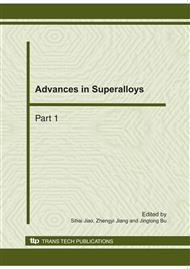[1]
TAPPONNIER P,BRACE W F. International Journal of Rock Mechanics and Mining Sciences and Geomechanics Abstracts,1976,13(4):103–112.
DOI: 10.1016/0148-9062(76)91937-9
Google Scholar
[2]
WONG T F. International Journal of Rock Mechanics and Mining Sciences and Geomechanics Abstracts,1982,19(2):49–64.
Google Scholar
[3]
LAJTAI E Z. Rock Mechanics and Rock Engineering,1998,31(4):237–250.
Google Scholar
[4]
MOORE D E,LOCKNER D A. Journal of Structural Geology,1995,17(1):95–114.
Google Scholar
[5]
CARLSSON B,NORDLUND E,ANDERSSON Y,et al. The failure process and the acoustic emission of brittle rock under compression[C]/ VOUILLE G,BEREST P ed. Proceedings of the International Congress on Rock Mechanics. Paris,France:A. A. Balkema,1999:569–572.
Google Scholar
[6]
EBERHARDT E,STIMPSON B,STEAD D. The influence of mineralogy on the initiation of microfractures in granite[C]/ VOUILLE G,BEREST P ed. Proceedings of the International Congress on Rock Mechanics. Paris,France:A. A. Balkema,1999:1 007–1 010.
Google Scholar
[7]
Richart F.E., Brandtzaeg A. and Brown R. L. A study of the failure of concrete under combined compressive stress. Bulletin 128, University of Illinois Engineering Experiment Station(1928).
Google Scholar
[8]
Cook N. G. W. An experiment proving that dilatancy is a pervasive volumetric property of brittle rocks loaded to failure. Rock Mech. Rock Engng 2, 181-188(1980).
DOI: 10.1007/bf01245573
Google Scholar
[9]
BRACE W F,PAULDING B W,SCHOLZ C. Journal of Geophysical Research,1966,71(16):3 939–3 953.
Google Scholar
[10]
Lajtai, E. Z., Carter, B. J. and Ayari, M. L. Criteria for brittle fracture in compression. Engineering Fracture Mechanics, Pergamon Press, 1990, 37(1): 59-74.
DOI: 10.1016/0013-7944(90)90331-a
Google Scholar
[11]
MARTIN C D,CHANDLER N A. International Journal of Rock Mechanics and Mining Sciences and Geomechanics Abstracts,1994,31(6):643–659.
Google Scholar
[12]
SAMMIS C G,ASHBY M F. Acta Metallurgica,1986,34(3):511–526.
Google Scholar
[13]
DEY T N,WANG C Y. International Journal of Rock Mechanics and Mining Sciences and Geomechanics Abstracts,1981,18(3):199–209.
Google Scholar
[14]
ZHANG J,WONG T F,DAVIS D M. Journal of Geophysical Research,1990,95(B1):341–352.
Google Scholar
[15]
KEMENY J M,COOK N G W. Crack models for the failure of rocks in compression[C]/ Proceedings of the International Conference on Constitutive Laws for Engineering Materials. Amsterdam:Elsevier,1987:879–887.
Google Scholar
[16]
A.C. Stevenson, Some Boundary Problems of Two-Dimensional Elasticity, Phil. Mag., 1943, 34 (7): 766-793.
Google Scholar


